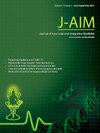Plants used in Ayurveda for Jwara or fever: A review of their antiviral studies
IF 1.9
Q3 INTEGRATIVE & COMPLEMENTARY MEDICINE
引用次数: 0
Abstract
Two of the earliest treatises in Ayurveda, the ‘Charaka Samhita’ and the ‘Sushruta Samhita’, describe numerous medicinal plants used in the treatment of Jwara (fever). Systematic studies carried out on these plants registered for ‘Jwara’ are of high significance in antiviral drug development.
This article is a comprehensive review of the antiviral studies on medicinal plants listed for ‘Jwara’ in ‘Charaka-Sushruta Samhitas’, their antiviral entities and modes of action.
The botanical names of the medicinal plants used for ‘Jwara’ were elucidated from their Sanskrit names in ‘Charaka-Sushruta Samhitas’ and their subsequent interpretations. Antiviral studies on these plant species and their constituents were compiled from the literature retrieved from Scopus, PubMed, Google Scholar and other databases. Antiviral activities against various viruses were evaluated based on EC50/IC50/LC50 values, high percent inhibitions and molecular docking parameters displayed by their extracts, secondary metabolites, short peptides, polyphenols, anthocyanins and polysaccharides. Their modes of action were also evaluated.
Strikingly, in antiviral studies very low EC50/IC50/LC50 and high percent inhibitions were demonstrated by medicinal plants widely used as traditional medicines, vegetables, foods and flavours. Secondary metabolites (including essential oils), anthocyanins, polyphenols, short peptides and polysaccharides in these plants illustrated antiviral activities by hampering membrane permeability, cellular functions and replication cycle of harmful viruses.
Medicinal plants used for fever in Ayurveda could be used as natural sources of lead molecules for antiviral drug development. Antiviral activities displayed by these plants are justifying the ancient wisdom traditionally demonstrated over centuries.
阿育吠陀用于发烧或发烧的植物:它们的抗病毒研究综述
阿育吠陀最早的两篇论文《Charaka Samhita》和《Sushruta Samhita》描述了许多用于治疗发烧的药用植物。对这些注册为“Jwara”的植物进行系统的研究对抗病毒药物的开发具有重要意义。本文对《Charaka-Sushruta Samhitas》中所列“Jwara”药用植物的抗病毒研究、抗病毒实体和作用方式进行了综述。用于“Jwara”的药用植物的植物学名称是从“Charaka-Sushruta Samhitas”及其随后的解释中阐明的梵语名称。对这些植物及其成分的抗病毒研究从Scopus、PubMed、谷歌Scholar等数据库中检索。根据其提取物、次生代谢物、短肽、多酚、花青素和多糖的EC50/IC50/LC50值、高抑制率和分子对接参数评价其抗病毒活性。对它们的作用方式也进行了评价。引人注目的是,在抗病毒研究中,广泛应用于传统药物、蔬菜、食品和香料的药用植物显示出极低的EC50/IC50/LC50和高百分比的抑制作用。这些植物的次生代谢物(包括精油)、花青素、多酚、短肽和多糖通过阻碍有害病毒的膜通透性、细胞功能和复制周期而显示出抗病毒活性。阿育吠陀治疗发烧的药用植物可以作为开发抗病毒药物的铅分子的天然来源。这些植物显示出的抗病毒活性证明了几个世纪以来传统的古老智慧是正确的。
本文章由计算机程序翻译,如有差异,请以英文原文为准。
求助全文
约1分钟内获得全文
求助全文
来源期刊

Journal of Ayurveda and Integrative Medicine
INTEGRATIVE & COMPLEMENTARY MEDICINE-
CiteScore
4.70
自引率
12.50%
发文量
136
审稿时长
30 weeks
 求助内容:
求助内容: 应助结果提醒方式:
应助结果提醒方式:


